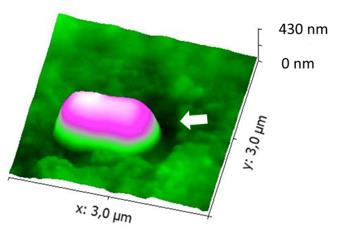Rechercher
Accueil > La Recherche > Axes & Equipes > Matière Molle & Verres > Equipe : Matière Molle > Thème : Matière molle pour l’agronomie et l’environnement
Biodegradation of polymers in a marine environment
publié le , mis à jour le
Biodegradation of polymers in a marine environment
People involved : M. George, T. Gaillard, P. Fabre
Pollution of the ocean by plastic litter has become a major environmental problem in recent years. One of the reasons of the increasing pollution by conventional plastics is their extreme durability, initially considered as an advantage, but which leads to their undesirable accumulation in terrestrial and marine environments, whether as such or in the form of micro-plastics. Even though the main degradation mechanisms have been identified (UV, waves, enzymes, bacteria), the degree to which “biodegradable” plastics actually biodegrade in the marine environment is still under debate.
Our aim is to deliver a comprehensive understanding of degradation mechanisms of polymers in marine environment, to lay down the basis for a generic model for the fate of plastics in the ocean (fragmentation versus biodegradation) and to draw new directions towards the design of innovative eco-friendly polymers.
We are focusing on :
– relating the physicochemical macroscopic characteristics of the polymer to its preferred degradation mechanisms in the ocean
– describing the biodegradation at the local level of bacteria, where fragmentation phenomena should occur.
In order to study degradation at the local scale of bacteria, we use atomic force microscopy (AFM) and measure both topographical and mechanical changes induced by the presence of the different degrading factors.

Figure : Topography image (AFM) of a marine bacteria on a polyethylene sample having spent 60 days in sea water. The bacteria has been slightly displaced using the tip of the microscope, leaving a mark (depth 40 nm) at its initial position (white arrow). This evidences bacteria-polymer interaction at short immersion times.
New concepts for eco-friendly materials are based on the synthesis of original block-copolymers.
In order to achieve this goal, we follow several threads :
– study of the degradation of plastics in a natural marine bacterial environment (collaboration with JF Ghiglione, LOMIC, Banyuls-mer)
– study of the degradation of polymers by cultured bacteria in the laboratory (collaboration with R. Grimaud, IPREM, Pau)
– tailoring of (bio)degradable co-polymers, with controlled morphological heterogeneities at the typical size of a bacteria (collaboration with S. Bruzaud, IRDL, Lorient and JM Raquez, LPMC, Mons, Belgium).








